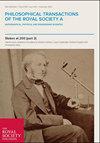早期太阳系的吸积速率,核心形成和挥发性损失
Philosophical Transactions of the Royal Society of London. Series A, Mathematical and Physical Sciences
Pub Date : 2001-10-15
DOI:10.1098/rsta.2001.0901
引用次数: 15
摘要
半衰期为105-108年的核素可以用来说明星云的时间尺度和星子的吸积速率。然而,半衰期为92myr的182Hf-182W体系也为类地行星的形成提供了新的、非常有用的约束条件。这项技术允许人们解决金属硅酸盐平衡的时间在不同的物体,如球粒陨石和地球。随着灵敏度和精度的提高,小行星上金属偏析的微小时间差异应该可以通过测量铁陨石来解决。已经很清楚的是,一些小行星大小的物体的形成和分化是在不到10兆尔的时间内完成的。相对于火星(可能小于20myr),地球(大于50myr)的吸积和地核形成被延长了。事实上,火星地幔似乎保留了核形成过程中残留的化学和同位素的非均质性。这些早期的特征似乎已经从地幔中消失了,大概是因为4.5 Gyr相对有效的对流混合。钨同位素数据为月球起源的“巨大撞击”理论提供了强有力的支持。月球是一个高Hf/W的天体,包含了球粒陨石W的主要成分,这与太阳系开始后超过50兆尔的形成时间相一致。新的高精度氧同位素数据无法解决地球和月球成分来源之间的任何差异。因此,巨大的撞击本身可能在这些物体之间产生了一些中等波动性元素预算的差异。这在早期月球样本的精确Sr同位素数据中得到了支持。这些数据与原地球和忒伊亚(撞击者)的Rb/Sr比值与现在的火星没有太大的不同是一致的。因此,长时间的吸积历史,而不是星云现象,可能是造成类地行星之间一些主要差异的原因。本文章由计算机程序翻译,如有差异,请以英文原文为准。
The rates of accretion, core formation and volatile loss in the early Solar System
Nuclides with half–lives of 105–108 yr permit the elucidation of nebula time–scales and the rates of accretion of planetesimals. However, the 182Hf–182W system with a half–life of 9_2 Myr also provides new and very useful constraints on the formation of the terrestrial planets. This technique allows one to address the timing of metal–silicate equilibration in objects as different as chondrites and the Earth. With improvements in sensitivity and precision, very small time differences in metal segregation in asteroids should be resolvable from measuring iron meteorites. It is already clear that the formation and differentiation of some asteroidal–sized objects was completed in less than 10 Myr. Accretion and core formation were protracted in the case of the Earth (greater than 50 Myr) relative to Mars (probably less than 20 Myr). Indeed, the Martian mantle appears to retain both chemical and isotopic heterogeneities that are residual from the process of core formation. Such early features appear to have been eliminated from the Earth's mantle presumably because of 4.5 Gyr of relatively efficient convective mixing. Tungsten isotope data provide compelling support for the ‘giant impact’ theory of lunar origin. The Moon is a high Hf/W object that contains a major component of chondritic W. This is consistent with a time of formation of greater than 50 Myr after the start of the Solar System. New highly precise oxygen isotope data are unable to resolve any difference between the source of components in the Earth and Moon. Therefore, the giant impact itself may have produced some of the differences in moderately volatile element budgets between these objects. This finds support in precise Sr isotopic data for early lunar samples. The data are consistent with the proto–Earth and Theia (the impactor) having Rb/Sr ratios that were not very different from that of present day Mars. Therefore, the extended history of accretion, rather than nebular phenomena, may be responsible for some of the major differences between the terrestrial planets.
求助全文
通过发布文献求助,成功后即可免费获取论文全文。
去求助
来源期刊
自引率
0.00%
发文量
0

 求助内容:
求助内容: 应助结果提醒方式:
应助结果提醒方式:


